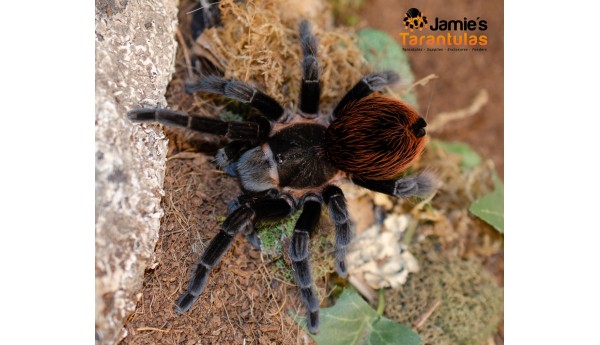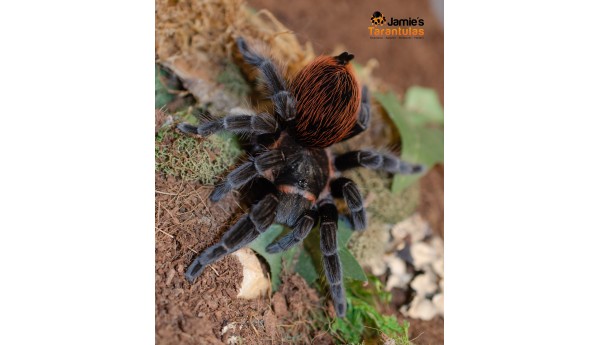Tliltocatl (form. Brachypelma) kahlenbergi (Veracruz Redrump) 1/2"
Recommended enclosure for 1/2" : Terrestrial spiderling enclosure kit. Recommended food: Currently feeding on prekilled pinhead B. lateralis.
Origin: New World. Native to Veracruz, Mexico.
Difficulty: Beginner
Type: Terrestrial
Adult Size: 5-6”
Growth speed: Slow
Longevity: Males 6+ years, females 20-40 years
Temperament: Docile yet skittish. If agitated T. albopilosus may flee and/or flick urticating hairs.
Bite potency: Mild
Urticating hairs: Yes
Ideal Temperature: 70 to 74°
Humidity: Low to Medium
Enclosure: The enclosure should be longer than it is tall. A good rule of thumb is the length of the enclosure should be a minimum of three times the diagonal legspan of the tarantula. Good ventilation is a must and safety should be a top priority when choosing and designing your tarantulas enclosure. The enclosure should not be too tall as to give the spider an opportunity to fall and injure itself. For spiderlings under about 1-1 1/4" we recommend the Terrestrial Spiderling Enclosure Kit. For specimens over 1" to about 2" we recommend the Terrestrial Juvenile Enclosure Kit.Specimens over 2" and under about 4.5 or 5" can go into a 7x7x11" complete terrestrial enclosure although because Curly Hairs can reach 5-6" in length we recommend the 8x8x14" Adult Complete Terrestrial as a permeant enclosure for 2-2.5" and over specimens. Click HERE to find out how to you measure a tarantula.
Substrate: While most adults will adopt a hide, slings often prefer to burrow. Cocofiber, vermiculite, peat moss and/or potting soil (or a mix) are all excellent substrate choices. Please make sure the substrate you choose is organic and chemical/fertilizer free. Do not use sand, pebbles, rocks or wood chips or anything else that could potentially cut or injure the tarantula.
In many cases a larger specimen would rather adopt or retrofit an existing hide than create it's own from deep substrate.Cork tubes half buried in substrate are what we use for our adult females. The specimen will excavate one side of the cork tube to it's liking. I like to think this makes the tarantula feel “at home” while minimizing the time and effort for the spider to settle in.
Larger spiders 2” and over should be provided with a shallow water dish in order to drink. The water bowl should be rinsed our every time it is refilled. Being a scrubland species they will not require as frequent misting as an arboreal species however, I recommend keeping one corner of the enclosure lightly misted, especially if there is no water bowl.
Feeding: Adults will eat every 6-14 days depending on the size of the spider and it's prey. Spiderlings should eat more often, every 5-10 days. Adults may be fed crickets, mealworms or roaches. Spiderlings under .75” can only eat food small enough for it to overpower. This includes pinhead crickets, flightless fruit flies & freshly hatched "pinhead" rusty red roaches. It is not advised to feed your tarantula wild-caught food. It could contain parasites or pesticides that could be fatal to your pet. Keep your tarantulas enclosure clean. food waste left in the enclosure will invite mold, mildew, mites, flies and other pests. It is advised to remove uneaten prey items after 3-12 hours. If using a feeder who will not “bother” a tarantula such as dubia roaches it is alright to leave them in the enclosure as long as they are not causing stress to the specimen. A more detailed feeding, misting & troubleshooting guide can be found here: https://jamiestarantulas.com/guides/
- $24.50 $45.00
- In Stock
Tarantula Care
Lorem ipsum dolor sit amet, consectetur adipiscing elit. Vivamus ultricies leo gravida purus facilisis eleifend at vitae eros. Nam vehicula lorem dignissim tortor euismod luctus. Mauris non consectetur dolor. Vivamus ut neque tempor enim hendrerit viverra eu et tellus. Curabitur ac volutpat mi. Vivamus congue ipsum et turpis consequat pellentesque. Vestibulum ante ipsum primis in faucibus orci luctus et ultrices posuere cubilia Curae.
Lorem ipsum dolor sit amet, consectetur adipiscing elit. Vivamus ultricies leo gravida purus facilisis eleifend at vitae eros. Nam vehicula lorem dignissim tortor euismod luctus. Mauris non consectetur dolor. Vivamus ut neque tempor enim hendrerit viverra eu et tellus. Curabitur ac volutpat mi. Vivamus congue ipsum et turpis consequat pellentesque. Vestibulum ante ipsum primis in faucibus orci luctus et ultrices posuere cubilia Curae.
Tarantula Tips
Lorem ipsum dolor sit amet, consectetur adipiscing elit. Vivamus ultricies leo gravida purus facilisis eleifend at vitae eros. Nam vehicula lorem dignissim tortor euismod luctus. Mauris non consectetur dolor. Vivamus ut neque tempor enim hendrerit viverra eu et tellus. Curabitur ac volutpat mi. Vivamus congue ipsum et turpis consequat pellentesque. Vestibulum ante ipsum primis in faucibus orci luctus et ultrices posuere cubilia Curae.
Lorem ipsum dolor sit amet, consectetur adipiscing elit. Vivamus ultricies leo gravida purus facilisis eleifend at vitae eros. Nam vehicula lorem dignissim tortor euismod luctus. Mauris non consectetur dolor. Vivamus ut neque tempor enim hendrerit viverra eu et tellus. Curabitur ac volutpat mi. Vivamus congue ipsum et turpis consequat pellentesque. Vestibulum ante ipsum primis in faucibus orci luctus et ultrices posuere cubilia Curae.






